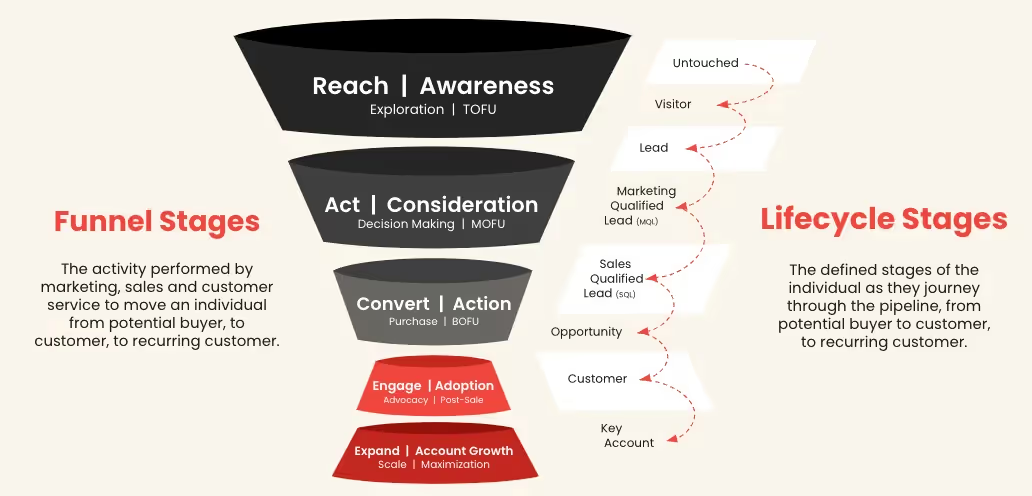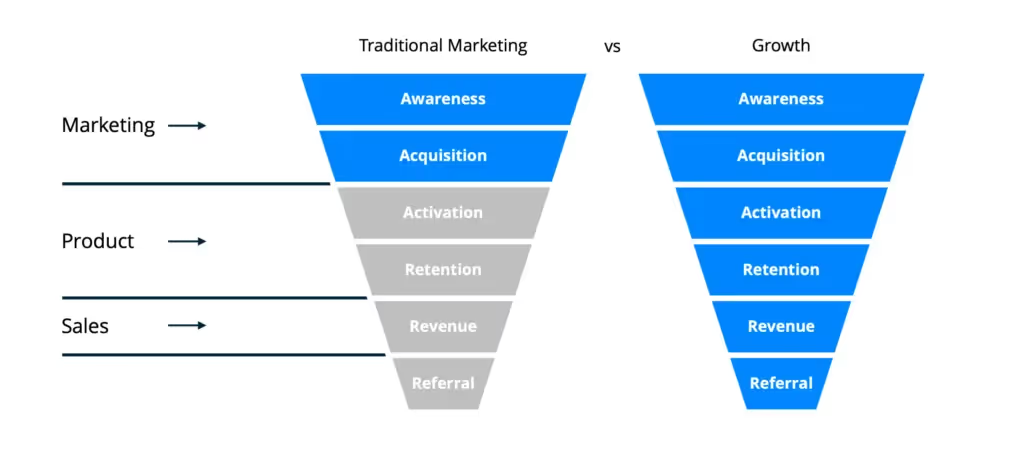In this breakdown of demand generation, we’ll define the practice, show its importance, and share tactics.
We’ll show you how to create effective demand generation strategies and show you the tools necessary for long-term success.
What Is Demand Generation?
In its simplest form, demand generation is the creation of consumer desire to purchase your product or service. Demand generation goes far beyond marketing. It bridges marketing, sales, and customer service and success to create demand and interest with your target market both pre- and post-purchase. It’s the process of relationship nurturing that builds interest for your business.
It’s about generating interest in your products and services across platforms and channels. Demand gen is a powerful way to create targeted interest and awareness of what you’re selling.
One of the great advantages of demand generation is the ability to measure results broadly and deeply. Demand gen is often mistakenly measured only on its lead impact, but it can also be measured in brand engagement metrics (traffic through to lead generation,) pipeline metrics such as conversion rates and velocity and/or business metrics like deal size, customer acquisition cost and annual recurring revenue.
Demand Generation vs. Lead Generation: What’s the difference?
Because demand generation marketing often is associated with securing leads, people often get thrown off by terminology. Demand generation reflects your business is about attracting audience interest by creating resources and messaging your customer's desire.
Demand generation differs from lead generation. What is lead generation? It uses nurturing – a process that converts readers to customers. Lead or leads generation converts viewers to customers after you’ve convinced them that you’re the thing they need.
Lead generation tactics include sign-up forms on websites that allow visitors to register for newsletters. Another common tactic is a call to action at the end of a blog post, inviting readers to a free consultation.
Another way to think about it is this: Lead generation allows you to convert, demand generation allows you to grow.
Why is Demand Generation an Important Component of Your B2B Marketing Strategy?
A McKinsey report notes the foundational shift in marketing today the “consumer decision journey.” Customers – B2B or B2C -- are in control, and their decisions at multiple stages can shape whether you make a sale.
On the B2B side, marketers need to recognize how deeply empowered customers are today. They have multiple choices for nearly everything they purchase, accessible at any time.
As customers compare and consider products, they will go through multiple rounds of evaluation and assessment. Marketers need to align their work to the buyer’s journey to know how to generate demand. That means measuring and growing brand awareness and customer attitudes. They also need to understand the needs and wants of their target customer.
In B2B marketing, demand generation is crucial. Demand generation serves several essential functions of your marketing operation. Specifically, demand generation helps your business:
- Expand Market Reach and Market Share. A demand generation campaign delivers materials and messages designed to build trust in your brand, business, and products. This content needs to reflect not just what your company is, but also what it can do. What problems can it can solve for customers? An effective B2B demand generation campaign knows what customers’ pain points are and speaks directly about solutions to alleviate issues. By showing the value your brand brings to a B2B customer, you engender trust and, in time, market share.
- Customer Reengagement and Relationship Nurturing. It’s far less expensive to re-engage a customer than to recruit a new one. It’s cost-effective to develop generation strategies that reconnect customers to your brand. Extending, advancing, and growing the relationship leads to more sales, more opportunities, and deeper ties to your company. Reconnection takes some creativity but may include strategies such as product updates or user satisfaction surveys. Resonant content and contacts that are relevant to where your customer is in their journey with your brand make sense. Building rapport extends the customer’s lifetime relationship with you and provides more revenue opportunities.
- Larger Deals and ROI. With enhanced brand affinity and reputation, you’re likely to secure more and bigger orders from B2B customers. You’ll also have more chances to convert visitors and past customers into new or recurring business. By securing regular, repeat, and upgradeable customers, you’ll see a faster and larger ROI, too.
Top Benefits and Challenges of Demand Generation
As with any marketing strategy, there are advantages and disadvantages to demand generation. Here is a closer look at some of the key benefits and challenges marketers face.
Benefits of Demand Generation
There are considerable benefits to focusing on demand generation as part of your overall marketing strategy, including:
- Increased Brand Interest. More than anything, demand generation is an opportunity to define and express your brand. Your demand generation strategies will drive brand awareness by showing what your brand values, stands for, represents, and offers. Demand gen builds excitement and helps customers identify companies they want to buy from. With demand generation, you can help customers see what you can do for them and add value to their businesses or lives
- Improved Quality of Leads. Having many leads is a good thing. However, what’s more important is having quality leads that are more likely to lead to conversions to sales. With targeted content and campaigns, you’ll attract ideal customers to your website and products or services. In addition to more volume, you’ll get leads more inclined to purchase what you’re offering. In turn, better leads result in lower acquisitions costs per lead
- Increased Customer Engagement. Customers, whether B2B or B2C, want relationships with the brands they use. With better demand generation, you begin to build those relationships earlier, sometimes even before a sale is made. You’ll be able to create, nurture and deepen relationships with relevant, high-value information catered to the buyer persona
- Higher Retention Rate. You need customers to be sticky, returning time and again to your brand for the products and services they need. With stronger relationships, driven by relevant information and engagements, you’ll garner better customer retention rates. The ROI on your marketing will skyrocket given customers with longer lifetime values for your brand, too
Challenges of Demand Generation
Every marketing strategy comes with inherent challenges. Demand generation is no exception. Among the challenges (all surmountable) are:
- Building an Audience. Every marketing campaign and every brand needs to start somewhere. With demand marketing, one challenge is to build an audience. Once you’ve created the campaign and the content, you need to send it to someone. Building an audience can take time, and leveraging social media to re-engage existing customers and attract new ones is necessary when starting out.
- Developing the Content. In order to be effective, demand generation campaigns need good, quality content. Finding the right creators for content marketing can be a challenge. However, there are many freelance options that can help you find people. Creating blogs, social posts, graphics, emails, and other creatives is possible but may take time
- Budget Constraints. Budget challenges are a part of any business and you may be wrestling with how to manage limited marketing resources. You have a couple of options. Start with hiring some in-house talent for basic demand generation. Or hire an outside agency to do the work for you. You may also choose a hybrid approach, with an internal marketer handling some demand gen work
- Aligning Sales and Marketing. Sales and marketing are inextricably linked. Unfortunately, some organizations have misaligned departments, with the two operating in silos. A shared understanding of needs, goals, and priorities can help strengthen the relations and deliver better results
- Turning Leads into Customers. Demand generation is about identifying opportunities. Converting those leads and relationships into sales is critical. It’s why there needs to be a strategy for what to do with engagements that result from customer demand generation work
How to Create and Implement a Demand Generation Strategy
It can be daunting to think about where to start with your demand generation strategy. Here are the key steps to take.
Define Your Target Audience
Your target audience is a specific group of customers who are most likely to purchase your product or service. That makes them the best groups to focus on ad campaigns.
You can develop your target audience based on various criteria, including:
- Interests, such as hobbies, entertainment preferences, political beliefs, or identifying traits
- Subcultures, defined as people with the same shared experience, such as race, gender, religion
- Intent to Purchase, such as those customers with the same pain points, needs, inclinations, or interests in your product or service
Developing your target audience starts with analyzing your customer base. You can conduct focus groups or surveys and identify patterns among those who have or are likely to purchase.
Correlate those insights with market research and competitive analysis. You will soon get a clearer understanding of who your customers are and should be.
Creating Your Buyer’s Journey – Buyer Persona
Buyer personas force you to develop a profile for each target audience. They include the demographics, personalities, characteristics, and needs of each audience. Personas should be data-informed, based on insights gleaned from data, surveys, and analysis.
Set a Goal
What do you want to achieve with your demand gen campaign? Start by developing goals that are measurable and related to the following factors:
- Customer Insights. You’ve researched your customers and developed your target audience. Your goals should reflect the audiences, whether you’re looking for more conversions, more visitors, more downloads, more reviews, or more revenue
- Budget. Your goal needs to be achievable within your budget constraints and the resources (personnel and dollars) available
- Tracking. How will you measure the impact of your demand generation work? Your goal needs to be capable of being tracked and measured
Create Your Content Strategy
Demand generation often is a content-heavy approach. Your content strategy will depend largely on “where” you and your likely customers are on the buyer funnel.
At the top of the funnel, you’re looking to garner interest and create a powerful brand identity. Blogs, videos, white papers, eBooks, and rich on-page content are important components here.
Free tools, giveaways, free trials, and samples are other tactics that can effectively drive customers deeper into the funnel.
Nurture the Leads You’ve Gathered
Demand gen is about finding more and better leads. Nurturing those leads is essential for success. That means coordinated work between your sales, marketing, and customer service teams.
The middle of the funnel lends itself to programs that nurture the relationship. For example, you may ask potential customers to sign up for your mailing list. These contacts can receive a sequenced cadence of emails that invite them to learn more, visit your site or take advantage of sales and coupons.
At the bottom of the funnel, you want to continue to personalize. Offer deeper insights into case studies or personal assistance via your help desk to assist customers who are ready to buy.
Measure the Success of Your Demand Gen Strategy
Measurements are so important. You’ll need systems that can track your campaigns, tagging customers to specific approaches and tactics.
Measuring your success often takes time. You’ll want to have multiple campaigns to compare before deciding how to adjust, affirm or enhance your campaign strategies.
Tools for a Successful Demand Generation Strategy
There are many tools you can use to develop and measure the impact of a demand gen strategy. Here are a few of the tools you may consider:
- Website Analytics. Who is visiting your website? What pages do they visit? Understanding your traffic, where it comes from, and where it goes is incredibly valuable
- LinkedIn. Looking to find people and companies that are ideal for building your customer base? LinkedIn Sales Navigator is a powerful way to find companies, employees, and contact information
- Automation Tools. Use automation tools to create, schedule, and manage your demand gen content, from social media to blogs to emails
- A/B Testing. If you’re looking to test different messages, using A/B testing tools lets you segment, test, and evaluate
- CRM. Your customer relationship management (CRM) tool needs to play a pivotal role in your demand generation strategy. From contacts to responses to engagements, the CRM can track every critical connection with your customers
How to Measure Success in Your Demand Generation Strategy
How will you define success for your demand gen strategy? There are multiple ways to measure the impact and efficacy.
The Best KPIs for Your Demand Generation Strategy
Here are a few of the best measures to use:
- Overall Traffic and Organic Traffic to your website
- Net-New Revenue. This measure is defined as revenue generated by a marketing strategy. This measure indicates what percentage of your overall revenue comes from demand generation (versus sales or channel partners)
- Marketing Qualified Lead (MQL). This metric shows what leads are brought in by the demand generation marketing campaigns. Another good metric is the percentage of overall leads developed via demand gen
- Sales Qualified Opportunity (SQO). This is a qualified prospect who has a high probability of becoming a customer. An opportunity should have a pain point your product or service can solve and an interest in the offering.
- Win Rate. This measure is the ratio of opportunities won divided by total opportunities
- Customer Acquisition Cost (CAC). This KPI shows the cost of gaining a new customer. It’s calculated by taking the cost of your marketing work and dividing it by the opportunities won
Tools for Measuring Demand Generation ROI
Longitudinal insights into your demand gen work can help develop success measures and make the case for additional investments in marketing work. Lead attribution is essential for tracking your progress and making a course adjustment.
Consider the following tools for helping to measure demand generation ROI:
- Marketing Analyzers. Use these tools to track the impact of your marketing across your website. They let you track individuals or groups anonymously and measure ROI on customers coming from different platforms
- Google Analytics. Google offers free tools that show where traffic comes from and where visitors go on your site
- Customer Lifetime Value Calculators. These customizable free tools help you define and calculate the lifetime value of your customers
- Content Sharing Trackers. These tools measure how your content is shared across social channels
High-Value Marketing Based on Relationships
Demand generation is both science and art. It takes some rigorous research to identify your customers and their needs. You’ll also need to experiment with personas, content, and messaging before you hit on the winning approach.
The science of demand gen is based on the impact of a data-driven approach. Instead of acting on instinct, a demand generation strategy uses informed, proven approaches. As a result, your business has better leads, more conversions, and more success.































